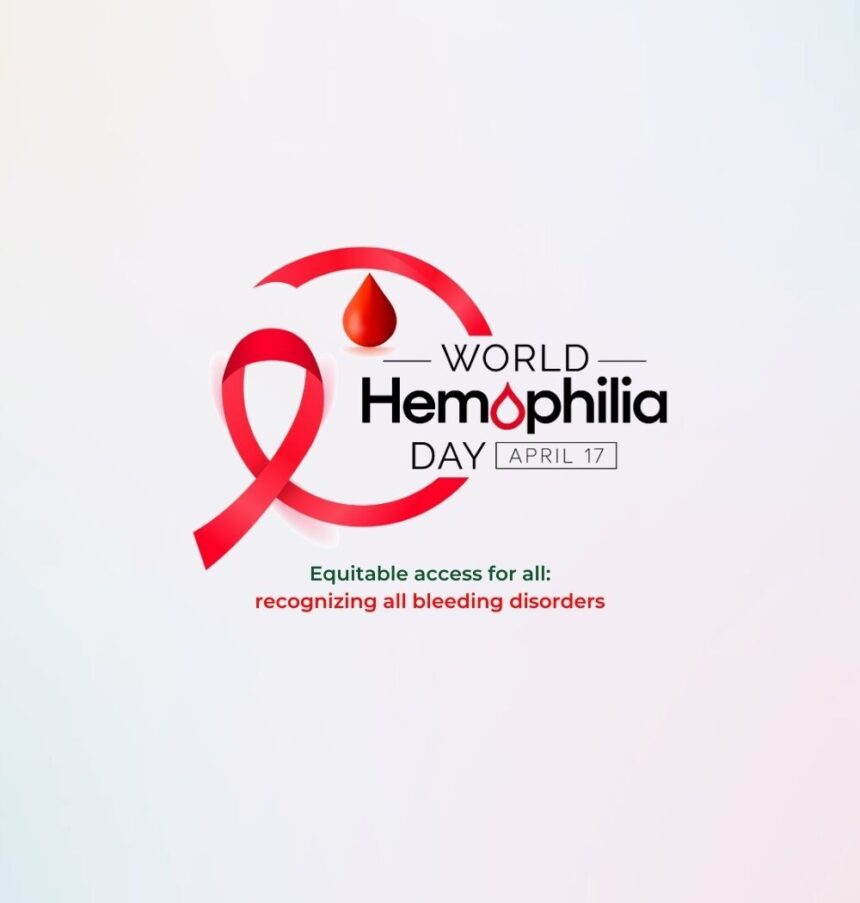🩸 9 Powerful Reasons Why World Haemophilia Day Demands Urgent Global Action
🌍 Introduction: A Day to Bleed Awareness, Not Just Blood
Each year, World Haemophilia Day is observed on April 17 to raise awareness and understanding of haemophilia and other bleeding disorders. This day isn’t merely a medical observance—it’s a global call to action, reminding the world that millions silently suffer from preventable or manageable conditions due to lack of awareness, access to diagnosis, or treatment.
- 🌍 Introduction: A Day to Bleed Awareness, Not Just Blood
- 🧬 What is Haemophilia?
- 📜 History of World Haemophilia Day
- 📅 Timeline of Key Moments
- 🧾 10 Key Facts About Haemophilia
- ❓ FAQs About World Haemophilia Day
- Q1. Why is World Haemophilia Day important?
- Q2. What are the symptoms of haemophilia?
- Q3. Is there a cure for haemophilia?
- Q4. Can women have haemophilia?
- Q5. How is haemophilia treated?
- 🔍 Significance of World Haemophilia Day
- 💔 1. Addressing the Treatment Gap
- 🩹 2. Normalizing the Conversation
- 🧬 3. Encouraging Early Diagnosis
- 🏥 4. Supporting Research and Advocacy
- 🧠 5. Educating the Next Generation
- 🎗️ How the Day is Observed
- 📝 Important Points to Remember
- 💌 Wishing Messages for World Haemophilia Day
- 🧠 Importance in Our Life and Society
- 🔄 1. Promotes Medical Equity
- 👨👩👧👦 2. Empowers Families
- 💼 3. Helps in Public Policy Advocacy
- 🧑🏫 4. Encourages Safe School Environments
- 🧪 5. Fuels Research Innovation
- 🧩 Daily Life Impacts of Haemophilia
- 🧭 Conclusion: From Awareness to Action
The theme of this day revolves around inclusion, equity, treatment, and visibility.
🧬 What is Haemophilia?
Haemophilia is a genetic bleeding disorder where the blood doesn’t clot properly due to the lack of clotting factors. People with haemophilia bleed longer—not faster—and even a small injury could be life-threatening if not managed properly.
There are primarily two types:
Haemophilia A (more common): Missing or low levels of Factor VIII
Haemophilia B: Missing or low levels of Factor IX
📜 History of World Haemophilia Day
Initiated in 1989 by the World Federation of Hemophilia (WFH), headquartered in Canada.
The date April 17 was chosen in honor of Frank Schnabel, the founder of WFH, born on this day.
The first official event was a global campaign to increase diagnosis and treatment facilities in developing nations.
Since then, the observance has grown into a global movement, observed in over 125 countries through awareness rallies, webinars, blood donation drives, and lighting up landmarks in red.
📅 Timeline of Key Moments
| Year | Milestone |
|---|---|
| 1963 | WFH founded by Frank Schnabel |
| 1989 | First World Haemophilia Day celebrated |
| 2000s | WFH launches “Treatment for All” campaign |
| 2017 | Focus shifted to “sharing knowledge” |
| 2020–25 | Emphasis on access to care in low-income countries |
🧾 10 Key Facts About Haemophilia
🧬 Haemophilia mostly affects males, though females can be carriers and occasionally affected.
🩸 1 in 10,000 people is born with Haemophilia A.
🧪 No permanent cure yet—but early diagnosis and therapy can make life normal.
🏥 People with haemophilia need replacement therapy, injecting missing clotting factors.
🌍 Around 75% of people with bleeding disorders globally do not receive adequate treatment.
👶 It is typically diagnosed in infancy or early childhood.
🧫 New therapies include gene therapy and recombinant factor replacements.
💉 Spontaneous internal bleeding is common and can damage joints, muscles, and organs.
🌐 Developed countries have early intervention programs, but many low-income nations don’t.
🧑⚕️ Haemophilia is not contagious—it’s inherited genetically.
❓ FAQs About World Haemophilia Day
Q1. Why is World Haemophilia Day important?
It raises global awareness of haemophilia and highlights the need for equitable access to treatment and diagnosis.
Q2. What are the symptoms of haemophilia?
Prolonged bleeding, spontaneous internal bleeding, excessive bruising, blood in urine/stools, joint pain due to internal bleeding.
Q3. Is there a cure for haemophilia?
Currently, no complete cure, but advanced therapies and factor replacement treatments manage it effectively.
Q4. Can women have haemophilia?
Yes, though rare. Most women are carriers, but some may exhibit mild to severe symptoms.
Q5. How is haemophilia treated?
By injecting clotting factor concentrates (Factor VIII or IX), and newer gene therapies are under clinical trials.
🔍 Significance of World Haemophilia Day
💔 1. Addressing the Treatment Gap
Nearly 3 out of 4 people with haemophilia don’t have access to proper care. This day shines a spotlight on these disparities.
🩹 2. Normalizing the Conversation
Haemophilia is often stigmatized or misunderstood in many cultures. Awareness helps families and communities be more empathetic.
🧬 3. Encouraging Early Diagnosis
In many cases, delayed diagnosis can lead to irreversible damage. Timely awareness can save lives and joints.
🏥 4. Supporting Research and Advocacy
Governments and donors often need a reminder of the urgency of investing in treatment development and gene therapy.
🧠 5. Educating the Next Generation
By spreading awareness in schools and colleges, we help normalize genetic conditions and remove the taboo surrounding them.
🎗️ How the Day is Observed
🏢 Lighting up landmarks in red to symbolize bleeding disorders
🩸 Blood donation and awareness camps
📣 Public campaigns about symptoms and available treatments
🧪 Free screening drives in hospitals and rural areas
🎥 Webinars, documentaries, and interviews with patients and doctors
🤝 Patient support groups organize awareness walks and events
📝 Important Points to Remember
| Element | Details |
|---|---|
| 📅 Date | April 17 |
| 🌍 Founded By | World Federation of Hemophilia (WFH) |
| 🧬 Primary Disorders | Haemophilia A & B, von Willebrand Disease |
| 📌 Main Goal | Global access to diagnosis & treatment |
| 🏥 Therapy | Factor VIII/IX replacement, gene therapy |
| 💡 Related Days | Rare Disease Day (Feb 28), Blood Donor Day (June 14) |
💌 Wishing Messages for World Haemophilia Day
🩸 “This April 17, let’s shed ignorance—not blood. Spread awareness and support the fighters of haemophilia.”
🧬 “Wishing strength to all warriors battling blood disorders. You are never alone.”
💉 “Let’s give the gift of life through awareness, education, and support.”
🏥 “No child should bleed in silence. Join hands to make haemophilia care accessible for all.”
🌍 “On World Haemophilia Day, we pledge to bring equity to every drop of blood that matters.”
🧠 Importance in Our Life and Society
🔄 1. Promotes Medical Equity
Haemophilia care is not uniformly available. This day is crucial in bridging the urban-rural and global healthcare divide.
👨👩👧👦 2. Empowers Families
Early education helps families manage emotional, financial, and medical aspects of haemophilia with strength.
💼 3. Helps in Public Policy Advocacy
It pressures governments to include bleeding disorder treatment in universal healthcare packages.
🧑🏫 4. Encourages Safe School Environments
Children with haemophilia can lead normal lives if schools are educated on proper first aid and risk prevention.
🧪 5. Fuels Research Innovation
Global awareness fuels research funding, trials, and pharmaceutical breakthroughs like gene therapy.
🧩 Daily Life Impacts of Haemophilia
Physical: Joint deformities from internal bleeding if untreated
Financial: Lifelong therapy can be very expensive in private setups
Social: Children may feel isolated or bullied due to activity restrictions
Emotional: Mental health challenges like anxiety or fear are common
Occupational: High-risk jobs are usually avoided, limiting income opportunities
However, with proper care, individuals with haemophilia can lead healthy, productive lives—from being athletes and doctors to entrepreneurs and artists.
🧭 Conclusion: From Awareness to Action
World Haemophilia Day is not just about red ribbons and hashtags. It is a deeply personal and emotional movement for millions. It’s about ensuring that no one suffers in silence because of their blood.
From policymakers to pediatricians, from teachers to friends—we all have a role to play.
So this April 17, don’t just observe—act. Share a fact, donate to a foundation, or simply spread a kind word.
Because awareness is the first step in saving a life that bleeds differently.








